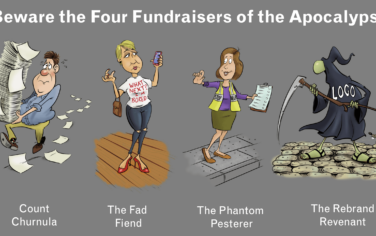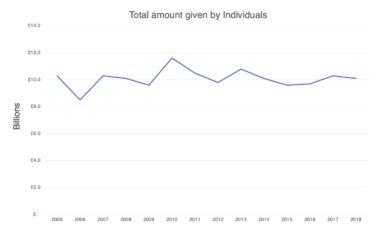The Bleedin’ Obvious Guide to Why Income Usually Falls After a Rebrand
Because nothing says give generously like a logo no one recognises.
Some of you might remember a LinkedIn post I wrote a while back looking at what tends to happen to income after a charity rebrands. You can find it here, but – spoiler alert – if you're expecting a rebrand to boost your income, you're probably in for a let-down.
Here’s why.
1. You’re not the same anymore (and isn’t that the point?)
The whole point of a rebrand is to change how your charity is perceived. If there’s no change, it’s probably not much of a rebrand. But change comes at a cost. What you gain in freshness and aesthetic appeal, you risk losing in recognition.
This is where we get into cognitive fluency – the psychological principle that the easier something is to process, the more we trust it. Donors (especially older ones) respond to the familiar – your name, your logo, the envelope design, the tone of your appeals, even the name at the bottom of the letter.
Change these, and you risk dropping off their mental “safe list.” You’re no longer their charity. You’re just another envelope, another email asking for money. And most of those don’t even get opened.
I spoke to a donor recently who said, quite simply, “If I don’t recognise it, it goes straight in the bin.” And it’s even worse with email, where an unfamiliar brand can look like spam – or a scam.
Even your most loyal supporters may never get the chance to discover the new you. Because the new you didn’t pass the first test – do I know and trust this communication enough to open it?
2. Your values start to diverge
People often talk about charities in terms of shared values. Supporting a specific charity says something about who they are. Giving isn’t just generosity – it’s about expressing an identity.
So, when a charity suddenly looks a bit slick and corporate, it can start to feel unfamiliar or alienating.
Supporters won’t necessarily think, “This no longer aligns with who I am,” but they’ll often feel a quiet sense that this isn’t really for me anymore.
That feeling can obviously undermine emotional connection. The authentic, morally grounded organisation they once supported now feels like it’s aiming for a different audience. And when that happens, giving slows – or stops. After all, none of us like to think that we don’t belong.
3. A commercial look comes with a charitable cost
Let’s not kid ourselves - a shiny rebrand doesn’t just look expensive; it is expensive. And donors know it. In a sector built on trust and shared purpose, a corporate-feeling identity can quietly provoke doubt. “Is this really where my money is going?”
It taps into two powerful emotional responses: scepticism (are we both concerned about the same thing?) and moral dissonance (can something that looks like a business still be doing good?). That’s a dangerous mix – especially for legacy supporters and mid-value donors who see themselves as long-term partners in your mission.
To them, you may no longer look like a cause. You look like a brand. And that creates just enough friction to make someone think twice about giving.
4. You’ve broken the emotional bond
Charities and donors build relationships - over years, through stories, shared values, appeals, and even tone of voice. All of this creates affective attachment - the feeling of “this is my charity.”
A rebrand, especially one introduced without explanation or supporter involvement, can be highly disruptive. Donors don’t just see new colours or messaging - they feel like the organisation they loved has changed, and they don’t understand why. Especially if they never opened the letter or email that introduced the change (see point one).
There’s rarely anger. No complaints. Just silence: the regular gift eventually cancelled, the next appeal ignored. A relationship ended not with a bang – but a whimper.
So, should you rebrand?
If you need a rebrand, you need a rebrand. Just make sure you’re doing it for the right reasons - to right a wrong or because of a major cultural change.
But don’t fall for the idea that a rebrand will turn around a failing appeals programme. It very, very, very probably won’t.
Without a massive boost to expenditure, income will usually fall. It will eventually climb again, but in most cases this will take years. And by the time your rebrand has built enough familiarity to regain the trust you once had, there’s a decent chance a new Head of Comms will be ready to start the process all over again.
After all, there aren’t many sectors besides charity where people will cheerfully throw away a well-loved and recognised brand and pay good money for the privilege of doing so.
The rebrand that boosts income is a rare beast. They do exist – but when they work, it’s usually because of a perfect storm of strategy, timing, leadership, and luck.
So if someone tells you a rebrand will raise income, ask them – with love – how they plan to overcome the bleedin’ obvious points I’ve just covered in their brand strategy.
It may well save you a huge amount of time and money.
First published on Substack 22nd April
The Essentials

Crack the Code to Regular Giving: Insights, Strategies, and a Special Giveaway!

‘Tis Halloween. Keep to the light and beware the Four Fundraisers of the Apocalypse!

Why do people give? The Donor Participation Project with Louis Diez.

A guide to fundraising on the back of a postcard

What does the latest research tell us about the state of fundraising?






